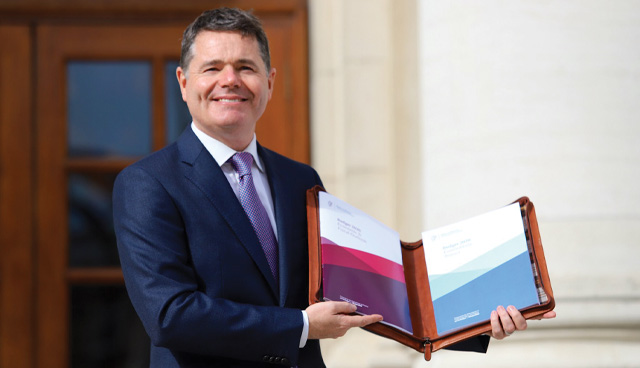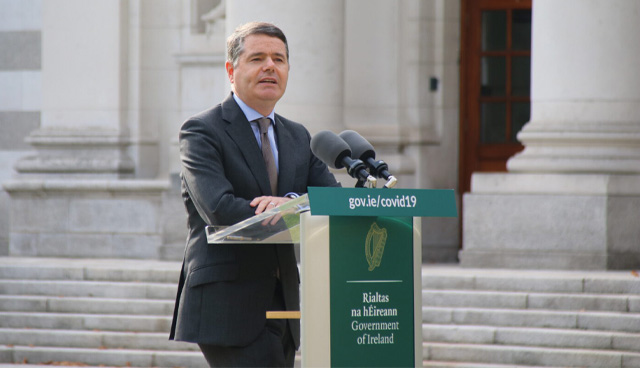The Pandemic: One year on

Addressing the ESRI in March 2021, Finance Minister Paschal Donohoe TD delivered a speech titled The Pandemic: One Year On in which he emphasised the fundamentals of the Irish economy, acknowledged the impending challenges and outlined how these could be overcome while “relentlessly pursuing many opportunities”.
Remarking that the labour market has been “turned on its head”, the Minister for Finance emphasises that at the time of his speech, over one million people were in receipt of either the Pandemic Unemployment Payment (PUP), the Employment Wage Subsidy Scheme (EWSS) or were on the Live Register.
Asymmetry
Delving into these figures, Donohoe acknowledges the disparate impact the pandemic has had across the labour market in three ways. Firstly, public-facing sectors have been most adversely affected due to their inability to easily pivot to remote working and social distancing. As such, job losses and business closures have been concentrated in sectors such as a hospitality, leisure, and personal services.
“To put this into perspective, the number of hours worked in the food and accommodation sector fell at an annual rate of 53 per cent in the fourth quarter of 2020,” the Minister says, adding: “On the other hand, hours worked in the information and communications sector… rose 3 per cent over the same period.”
Secondly, he highlights the disproportionate impact on young workers. While the total unemployment rate was 19.8 per cent, the rate of unemployment among the 14-24 age cohort increased to 46 per cent in Q4 2020. This is partly due to the prevalence of young workers in contact intensive sectors.
Thirdly, workers with lower educational attainment were also severely impacted, with a 10 per cent decrease in the number of people without a third level qualification who were employed in Q4 2020. At the same time, the corresponding figures for those with a third level qualification increased.
Each of these disparities has an impact on the long-term policy response. “This time last year, the thinking was that the pandemic was a system-wide, symmetric shock. It now appears that it is more of an asymmetric, sector-specific shock, with unique impacts,” Donohoe observes.
Response
At the time of speaking, the Minister indicates that a total of approximately €38 billion of government resources had been allocated to support households and businesses, ultimately aimed at mitigating the permanent impacts of the pandemic.
As such, at an aggregate level, household income increased in 2020. Indeed, CSO data indicates that during Q2 2020, median household income fell by almost 2 per cent compared with a counterfactual decrease of 20 per cent in the absence of government supports. Simultaneously, consumer spending has decreased in negative correlation to household income.
Consequently, as reflected in other advanced economies, aggregate figures for households point to an accumulation of savings. For example, in Q2 2020 the savings rate of the average household increased from €1 in every €10 of take-home pay to €4 in every €10 of take-home pay. In total, €15 billion of the €126 billion household deposits in the domestic banking system has accumulated in the last year.
“Importantly, this means that once the virus has been contained, the unwinding of the savings ratio will provide some support for economic recovery, at least in the short term,” Donohoe remarks.
Countercyclical policy response
A countercyclical policy response is possible for two reasons, he argues. Firstly, “careful management” of the pre-pandemic economy and secondly, favourable sovereign financing conditions.
In relation to economic management, the Finance Minister credits budgetary surpluses, the Rainy Day Fund, macro prudential tools and the structure of the tax system. These were, he argues, political decisions that enabled the State to enter the pandemic from a position of strength. At the same time, unlike during the previous crisis, this countercyclical policy response is now advocated by the European Commission, the IMF and the OECD.
Once the monetary support mechanisms come to an end, he projects: “The benefits of prudent economic management pre-pandemic alongside determined countercyclical support during the pandemic, will become evident.”
Fiscal and monetary policy
Minister Donohoe outlines three factors informing complementary fiscal and monetary policy. Firstly, he contends, the depth of the Covid crisis “necessitates a more aggressive countercyclical policy response”. Secondly, the impact of monetary policy is constrained by the zero-lower bound for interest rates. Thirdly, he reiterates the asymmetric nature of the crisis.
Therefore, while monetary policy is appropriate on an aggregate level, it cannot provide sector specific response and fiscal policy is required to support employment and income. This interaction, the Minister observes, has provoked a debate on the sustainability of public debt.
Irish debt to modified national income increased to 108 per cent or €219 billion in 2020 and is expected to increase further in 2021. Simultaneously, while debt is increasing, the debts service burden is falling in positive correlation with interest costs. As such, mirroring similar scenarios across advanced economies, Ireland’s interest bill absorbed 4.5 per cent of total revenue in 2020, compared with 12.5 per cent 2013.

“In order to reduce the vulnerability of the economy and the public finances to some of this uncertainty, reducing the debt ratio back to lower and safe levels must be a key priority over the medium-term.”
However, the Minister warns: “While the policy framework with respect to deficits and debt is evolving, this does not absolve us of the need to reduce our deficit over time.”
Published in late January 2020, the Department of Finance’s Annual Report on Public Debt in Ireland “emphasises that there is no single metric to show whether a country’s debt is sustainable or not”.
For Ireland, as a small country which cannot print its own money and which is a member of a monetary union in which monetary policy is “not always optimal for a small country”, he argues, maintaining sustainable public finances is vital. This entails a reduction in the interest bill, through a reduction of the deficit at an appropriate pace. “The idea that ‘deficits don’t matter’… is so far wide of the mark as to be dangerous.”
So, while countercyclical support is essential, it must be sustainable. A new balance must be struck, the Finance Minister suggests, between sustaining debt, managing the deficit and economic growth. “The need to manage our national finances differently will emerge. And it is in our interests to be ready for that moment,” he asserts.
Interest rates
Highlighting the absence of certainty around the future of interest rates, Donohoe notes increased inflation rates and accompanying inflationary expectations elsewhere globally. He also emphasises two certainties: firstly, greater public debt is “more painful” if there is an increase in borrowing costs; and secondly, “the more carefully a national deficit is managed the better the prospects for more affordable costs”.
Welcoming the European Commission’s communication of One year since the outbreak of Covid-19: Fiscal policy response, the Minister points to a number of initiatives to be delivered in coming months, including completion of the stability and convergence programmes, alongside preparation of member states’ recovery and resilience plans. Meanwhile, in Ireland, the Government intends to publish the National Economic Plan and the Medium-Term Plan to align public spending and revenue, as per the Programme for Government.
Overall, Donohoe indicates that the pandemic has redefined uncertainty and tail risk. “In order to reduce the vulnerability of the economy and the public finances to some of this uncertainty, reducing the debt ratio back to lower and safe levels must be a key priority over the medium-term,” he concludes.





